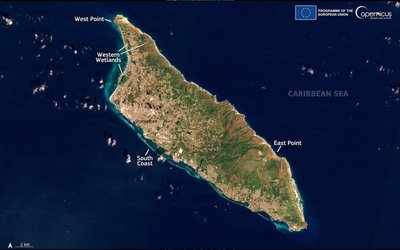The best way to combat increasing river flood risk in Europe? Water storage!
April 28, 2023

Photo: Flood barrier in the low-lying part of the city of Hamburg, Germany. Flood proofing of urbanised areas is a good option at the local scale but not for large areas.
Costs and benefits of flood protection
There are several options for adapting our rivers to higher flood peaks under global warming, and thus offset at least part of the flood risk increase due to climate change. What options to choose depends on the costs of implementing these measures and the benefits in terms of risk reduction. In addition to raising dykes, water storage areas can be created that can be flooded in a controlled manner to store excess water temporarily and reduce peak flows. Other options include flood proofing buildings and relocating people and their assets to other areas with negligible risk. The costs and benefits of these four key flood adaptation options across Europe have been assessed.
Current flood risk
In their study, the authors estimate that at present the average annual damage by river flooding in the EU and United Kingdom is €7.6 billion per year, while around 166,000 people are exposed to river flooding. Without climate mitigation, and global warming reaching 3 °C in 2100, and without further improvement of adaptation, average annual flood damage would rise to €44 billion per year by the end of the century, while annually nearly half-a-million Europeans would be exposed to river flooding. This increase is largely due to climate change. Further investments in adaptation will be needed to offset the projected rise in flood risk, the authors state.
Most effective: water storage
Water storage areas that reduce river flood peaks are economically the most attractive option to adapt the river system to the changing climate, the authors conclude. Under 3 °C global warming by 2100, an annual investment of €2.6 billion per year until 2100 would reduce annual economic damage and population exposed in the EU and United Kingdom by more than 80% by 2100. This means that flood risk throughout this century would more or less stay at the current level.
Slightly less effective: adaptation through river dykes
The optimal design of adaptation through river dykes in the EU and United Kingdom would require an annual investment of €3.1 billion until 2100 under the 3 °C global warming scenario. This would lower annual flood damages and the population exposed to flooding by about 70%. Additional investments in river dykes are therefore economically slightly less attractive than increasing flood storage capacity.
Flood proofing and relocation not effective on a large scale
Flood storage areas and river dykes are measures that reduce the hazard. Flood proofing does not change the hazard but can reduce the impact of flooding. This assessment shows that flood proofing is far less effective in reducing flood risk than the hazard-reduction measures. The reduction in damage by flood proofing of buildings in Europe is only 16%. The reduction of population exposed to flooding is zero, as flooding is not avoided. Flood proofing of buildings is not an effective strategy to protect large areas but can be an interesting additional measure for areas with a high concentration of exposed assets.
Of all four options, relocation is the least cost-effective. This option is economically convenient in only a few locations in Europe. As a result, the risk reduction that can be reached by relocation is almost zero.
‘Hybrid’ strategies
Naturally, we do not have to select only single type of measure. A combination of measures – ‘hybrid’ strategies – will likely be the best option to mitigate flooding at the lowest cost. Also, considering flood risk in land use planning will continue to be an effective way to reduce future flood impacts that cannot be replaced by adaptation strategies. After all, the projected increase of river flood risk is not just due to climate change but also due to the expansion of urbanisation in flood-prone areas.
Source: Dottori et al., 2023. Nature Climate Change 13: 196-202.








